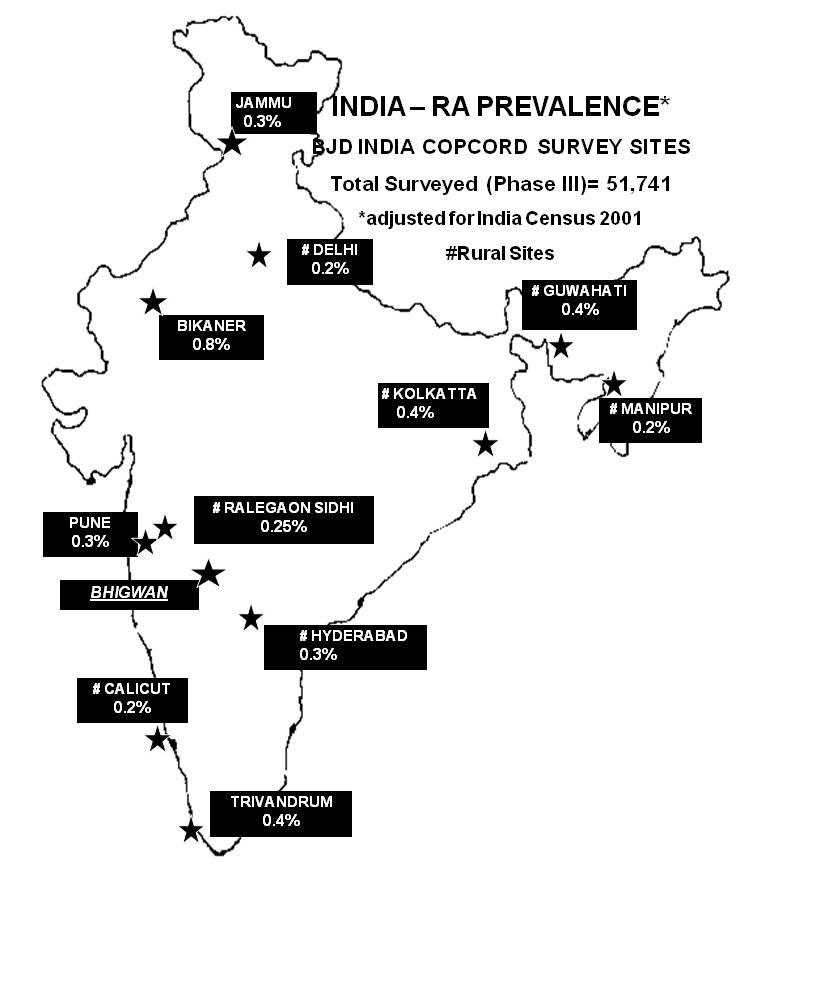Session Information
Session Type: Abstract Submissions (ACR)
Background/Purpose :
The 1 % prevalence of RA Worldwide is a deep rooted ancient dogma. None of the recent WHO ILAR COPCORD (Community Oriented Program for Control of Rheumatic Diseases) surveys Worldwide support this contention (Best Pract Res Clin Rheumatol 2008; 22:583-604); Cuba & Mexico being exception (J Clin Rheumatol 2012;18: 167-69). COPCORD Bhigwan (India) reported (J Rheumatol 2002; 29: 614-21) an unusually high rural prevalence of RA 0.55% (ACR 1987) and encouraged a country wide exploration. We now present the results of RA prevalence in India.
Methods:
We adopted the COPCORD Bhigwan model to complete non random population surveys (Stage I) at 12 sites (Fig)as per standard COPCORD methods (http://www.copcord.org); a cross sectional house to house population screen to identify cases with current/past pain (phase I) and evaluate (phase II) respondents for pain, impact, quality of life and rheumatology evaluation (phase III). All patients were examined by rheumatologists. 51,741 populations qualified for the current analysis. The classification/diagnosis was essentially clinical with minimal supporting investigations. Indigenously designed Windows based program was used for a central data entry and analysis using standard stat software.Data was further adjusted for age-sex standardization to India census population 2001; 95% confidence intervals shown in parenthesis. Site sample sizes, pain rates and prevalence of several rheumatic disorders are submitted in another abstract.
Results:
198 patients (83% women) were classified as clinical RA. The crude point prevalence was 0.38 (0.30, 0.44) and the adjusted rate was 0.34 (0.08, 0.79). The overall female to male ratio was 5:1. Patients were distributed in various age groups (years); 2% in 15-24, 42% in 25-44, 40% in 45-64, and 16% in 65+ age group. The adjusted prevalence rate of RA for each of the survey sites is shown in the figure. Except for the prevalence of 0.8% in a site in the state of Rajasthan (West India), a large number of sites in the rest of the country seem to be in the range 0.2 to 0.3%. However, even a low prevalence of 0.34% would mean that India (1.2 billion populations) has probably 5 million patients.
COPCORD surveys are limited by lack of investigations and follow up. In India, RA may be overestimated clinically because of a large pool of seronegative inflammatory arthritis (RA mimics). COPCORD Pune (India) reported a crude point prevalence of 0.45% RA which when reclassified as per ACR 1987 criteria and further standardized was reduced to 0.19% (J Rheumatol 2009; 36: 614-22).
We believe that the true prevalence of RA in India is likely to be even less than 0.34% and that may bring some solace.
Conclusion:
Though the prevalence of RA 0.34% in India is several folds less than the elusive 1% that has been taught for years, the burden of RA nonetheless is extremely high and needs to be seriously addressed at a national level.
Disclosure:
A. Chopra,
None;
R. Ghorpade,
None;
S. Sarmukkadam,
None;
V. Joshi,
None;
A. Mathews,
None;
L. Gauri,
None;
A. Rahim,
None;
K. Datta,
None;
S. Chaturvedi,
None;
B. Thakuria,
None;
A. Mahajan,
None;
R. Singh,
None;
A. Ghosh,
None;
R. Handa,
None;
M. Saluja,
None;
A. Venugopalan,
None;
V. Kunjeer,
None;
B. Paul,
None;
S. Pal,
None;
K. Wangjam,
None;
T. Kumar,
None;
K. Mahendranath,
None.
« Back to 2012 ACR/ARHP Annual Meeting
ACR Meeting Abstracts - https://acrabstracts.org/abstract/5-million-patients-and-not-0-34-is-worrisome-burden-of-rheumatoid-arthritis-in-india-based-on-a-bone-and-joint-decade-india-community-oriented-program-for-control-of-rheumatic-disease/

